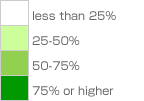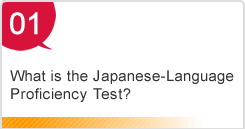The list summarizes "what successful JLPT examinees of each level think they can do in Japanese," based on self-evaluation survey results.
It is not a syllabus (question outline) of the JLPT, nor does it guarantee the Japanese-language proficiency of successful examinees. For language proficiency measured by the JLPT and question outline, please refer to "Summary of Linguistic Competence Required for Each Level."
The list can be used as a reference to help examinees and others get an idea of "what successful examinees of a particular level can do in Japanese."
※Please use "PDF for printout" when making hard copies, as the line height of tables varies by computer and character display size.
| N1 | N2 | N3 | N4 | N5 | |||
| 1 | I can understand the main points of TV news about politics, economics, etc. | ||||||
| 2 | I can understand the general content when I engage in conversations on current topics covered by the media. | ||||||
| 3 | I can understand the general content of speeches in formal situations (e.g. welcome parties, etc.). | ||||||
| 4 | I can generally understand announcements about unpredictable occurrences (e.g. accidents, etc.). | ||||||
| 5 | I can understand the content of inquiries about my work or specialized field. | ||||||
| 6 | I can understand the general content of lectures and speeches given on themes I am concerned about. | ||||||
| 7 | I can follow discussions when I participate in meetings at school or work. | ||||||
| 8 | I can understand the general content of discussions and debates on themes I am concerned about. | ||||||
| 9 | I can understand the general content of TV programs covering familiar everyday topics (e.g. cooking, travel, etc.). | ||||||
| 10 | I can follow discussions on familiar everyday topics (e.g. travel plans, preparations for parties, etc.) when I participate in meetings. | ||||||
| 11 | I can generally understand TV dramas and movies in standard Japanese. | ||||||
| 12 | I can get necessary information (e.g. features, etc.) from explanations about products at stores. | ||||||
| 13 | I can generally understand announcements at stations and department stores. | ||||||
| 14 | I can understand the general content when I engage in small talk and free conversations with people around me. | ||||||
| 15 | I can understand simple walking directions and directions for public transportation. | ||||||
| 16 | I can generally understand conversations on familiar everyday topics (e.g. hobbies, food, weekend plans, etc.). | ||||||
| 17 | When I am given simple instructions, I can understand what is required of me. | ||||||
| 18 | I can understand instructions from my teacher such as meeting times and places. | ||||||
| 19 | I can understand phrases commonly used at stores, post offices, and stations (e.g. "May I help you?" "It's ○○yen." and "Here you are.", etc.). | ||||||
| 20 | I can understand simple self-introductions by teachers and friends in classrooms. |
※Percentages of successful examinees of each level who think they "can do" an item are shown in four ranges. When estimating percentages, the responses of only "successful examinees near the passing line" were used. For details, please refer to "2.List preparation" at the beginning.

JLPT Can-do Self-Evaluation List

-
- *Outside Japan, the test may be held only in July or December in some cities. Click here for the test schedule in your city.
End of Text










